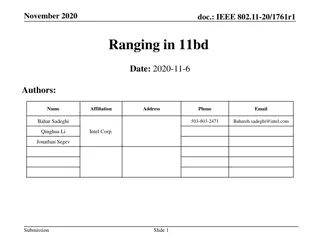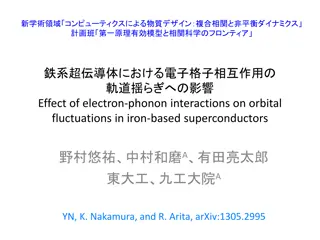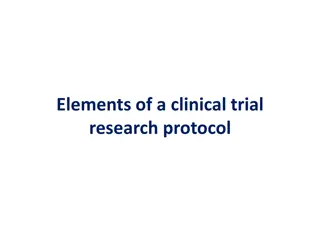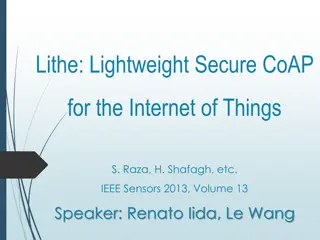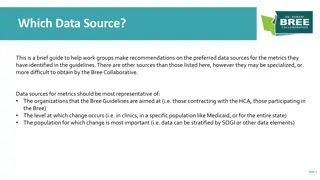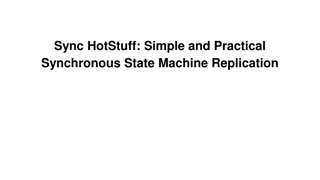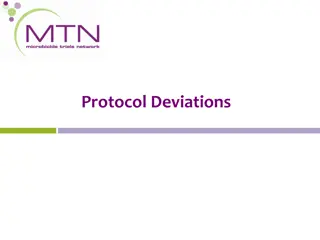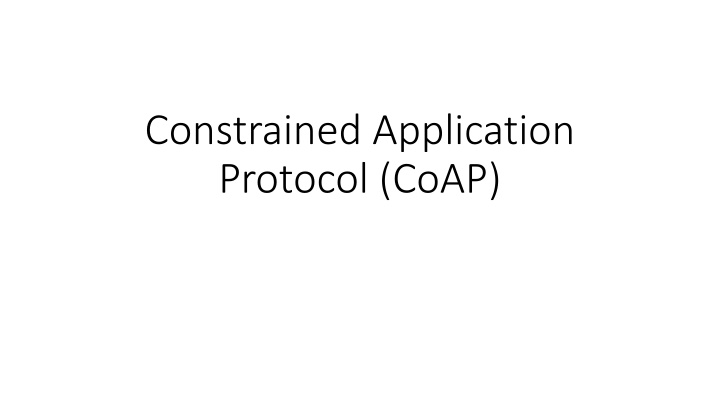
CoAP Messaging: Lightweight Protocol for IoT Devices
CoAP, a protocol designed for constrained IoT devices, operates over UDP and supports reliable messaging over low-powered networks. With a focus on asynchronous communication, CoAP utilizes unique message IDs and tokens for efficient message exchanges. Discover more about CoAP's messaging network layers and message model in this informative guide.
Download Presentation

Please find below an Image/Link to download the presentation.
The content on the website is provided AS IS for your information and personal use only. It may not be sold, licensed, or shared on other websites without obtaining consent from the author. If you encounter any issues during the download, it is possible that the publisher has removed the file from their server.
You are allowed to download the files provided on this website for personal or commercial use, subject to the condition that they are used lawfully. All files are the property of their respective owners.
The content on the website is provided AS IS for your information and personal use only. It may not be sold, licensed, or shared on other websites without obtaining consent from the author.
E N D
Presentation Transcript
Constrained Application Protocol (CoAP)
Intro The Constrained Application Protocol (CoAP) was created for smaller, constrained devices that run on low-powered networks with possibly transient or lossy connectivity. CoAP is similar to HTTP or REST communication in that the messages generally fall into the categories of GET, POST, PUT, and DELETE. The CoAP specification is maintained by the IETF. CoAP is very conversational by nature because it is request- and response-driven. Contrary to the publish/subscribe design of MQTT.
CoAP messaging network communication layers At a lower level, CoAP messages are sent and received over User Datagram Protocol (UDP), which by nature is unreliable, so a basic reliability scheme is built into CoAP on top of UDP. For added security, messages can be sent using the Datagram Transport Layer Security (DTLS) protocol instead of UDP. In either case, each CoAP message needs to fit into a single UDP/DTLS datagram packet. Further, CoAP supports datagram`m messaging over IPv4 and IPv6 networks and variants such as 6LoWPAN . Although unicast UDP is used for request- and response- driven CoAP, multicast UDP messaging is used to support CoAP device/sensor discovery. CoAP clients and servers support a special all CoAP nodes multicast address, with port 5683, to discover other CoAP servers and their shared resources.
The CoAP message model The CoAP message model All message exchanges in CoAP are like those for HTTP. With CoAP, all interchanges are asynchronous and datagram-based. Optional reliability is built into the message exchange using a timeout and retransmission protocol based on random and increasing back-off timers with eventual timeout. The CoAP two-layer messaging approach
CoAP messages CoAP messages include a four-byte fixed-length header. Depending upon the message type, this header is followed by optional header data and the payload. Each message includes a 16-bit message ID used to link requests to their accompanying acknowledgments (ACKs) or error statuses (when applicable). A non-confirmable (NON) message (that is, one that doesn t require confirmation or, hence, reliability) is sent from the client to the server with no ACK
NON request message and response If the recipient is unable to process the message, it may reply with a reset message (RST) to indicate this. An example of when high reliability may not be needed is with telemetry data, because there is a constant stream of updates so missing one update won t be a problem. message IDs are unique values that are used to identify duplicate messages and match confirmable messages (CONs) to ACKs. Tokens are unique values used to match requests to responses. client 1 sends a nonconfirmable GET request for a temperature reading to client 2. A unique message ID (0x101) and token (0x21) are provided. The message ID is useful to detect message duplication (more on that later). For a request/response message exchange, the token must match across all associated messages. In this example, the message IDs will be unique for both the request and response messages, but the token (0x21) will be the same for both.
A CON request message and response In the case of a NON message, either the request or the response may be lost. For some types of message exchanges, this may be acceptable. For cases where that is not acceptable, CoAP supports CONs. client 1 sends a confirmable GET request for a temperature reading to client 2, providing a unique message ID (0x101) and token (0x21). The token must match throughout the entire message exchange. When client 2 receives the CON request, it sends an ACK message containing the same message ID provided with the request. Later, client 2 sends a CON response message with the requested data and a new message ID, using the same token as in the CON request from client 1. To confirm that it received the data, client 1 sends an ACK to client 2 containing the same message ID as in the response (0x92ab), and the exchange is complete.
Piggybacking To reduce message traffic and processing overhead, CoAP supports the concept of piggybacking. With this, the response data to a request can be included (piggybacked) on the ACK message. The CON request is identical to the previous exchange. However, when client 2 sends the ACK, it also includes the response data. When client 1 receives this ACK with data, the CON message exchange is complete.
Lost ACK scenario The message retransmission timeout interval. When any CON message is sent, an ACK must be received within a random time interval that is somewhere between the ACK_TIMEOUT and a value calculated as (ACK_TIMEOUT * ACK_RANDOM_FACTOR). If an ACK is not received in time, the sender retransmits the CON message at exponentially increasing intervals until it receives an ACK (or an RST message) or it runs out of the number of attempts defined by the MAX_RETRANSMIT value. Each time a message is retransmitted, that message s transmit counter is incremented and its wait time is doubled.
CoAP method definitions CoAP method definitions CoAP messaging is analogous to HTTP communication, but it s not equivalent. For example, both CoAP and HTTP support the same four basic commands GET, POST, PUT, and DELETE but the semantics of the commands vary slightly. For instance, many of the success and error codes are different between the two. CoAP GET. As is the case with REST, this method retrieves a representation of the information that corresponds to the resource within the URI at the time the request is made. As is the case with HTTP, the request can include an Accept option that suggests the preferred content of the response. CoAP POST. A CoAP POST request asks the recipient to process the representation (data) enclosed within the request. The actual function performed by the POST is dependent on the target. It typically results in the target resource being updated or a new resource being created if it doesn t yet exist. If it s created, the response should include the new URI for it.








